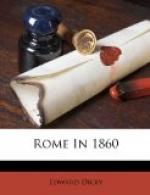except in the very fact of the assemblage. As
far as I could guess from my own observation, there
were about 6000 people present, and from 400 to 500
carriages; though persons who ought to be well informed
have told me that there were double these numbers.
No attempt at interference was made on the part of
the French. There were but few French soldiers
about, and what there were, were evidently mere spectators.
Pontifical gendarmes passed along the road at frequent
intervals, and, not being able to arrest a multitude,
consoled themselves with the small piece of tyranny
of closing the
osterias, which, both in look
and character, bear a strong resemblance to our London
tea-gardens, and are a favourite resort of thirsty
and dusty pedestrians. The crowd, nevertheless,
remained perfectly orderly and peaceful, and as soon
as the carnival-time was over, returned quietly to
the city. As I came back from the gate I passed
through the Corso just before the course was cleared
for the races. I have never seen in Italy a
rabble like that collected in the street. The
crowd was much such a one as you will sometimes meet,
and avoid, in the low purlieus of London on Guy Faux
day. Carriages there were, some forty in all,
chiefly English. One hardly met a single respectable-looking
person, except foreigners, in the crowd; and I own
I was not sorry when I reached my destination, and
got clear of the mob. Yet the report of the police
of the Pope was, that the carnival was
brilliante,
e brilliantissimo.
On the following day (Friday) much the same sort of
demonstration took place in the Corso. There
being no carnival, the whole street, from the Piazza
del Popolo to the Capitol, was filled with a line of
carriages, going and returning at a foot’s pace.
The balconies and windows were filled with spectators,
and the rabble of the previous day was replaced by
the same quiet, decent crowd I had seen at the Porta
Pia. The carriages, from some cause or other,
were more aristocratic in appearance; while the number
of spectators was much smaller—probably
because it was a working day, and not a “festa.”
By seven o’clock the assemblage dispersed,
and the street was empty. Meanwhile, Friday
afternoon was chosen for the time of a counter-demonstration
at the Vatican. All the English Roman Catholics
sojourning in Rome received notice that it was proposed
to present an address to the Pope, condoling with
him in his afflictions. Cardinal Wiseman was
the chief promoter, and framed the address.
Many Roman Catholics, I understand, abstained from
going, because they were not aware what the terms of
the address might be, and how far the sentiments expressed
in it might be consistent with their position as English
subjects. The demonstration outwardly was not
a very imposing one; about fifty cabs and one-horse
vehicles drove up at three o’clock to the Vatican,
and altogether some 150 persons, men, women, and children,
of English extraction, mustered together as representatives




